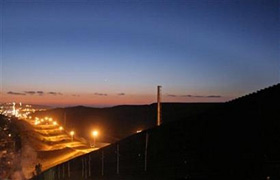 |
 |
 |
 Editorials | At Issue | March 2006 Editorials | At Issue | March 2006  
Plans for U.S.-Mexico Border Fence Draw Fire
 Tim Gaynor - Reuters Tim Gaynor - Reuters


| | The fence which divides Mexico and the U.S. is seen along the common border near the Mexican border town of Tijuana March 2, 2006. The income gap between the U.S. and Mexico is the principal reason why hundreds of thousands of Mexicans cross the border with the U.S. illegally to seek work - yet it rarely figures in the heated and increasingly emotional debate over immigration now raging in the United States. (Jorge Duenes/Reuters) |
Tijuana, Mexico, – Hurling himself over a steel fence into the no-man's-land between Mexico and California, an undocumented migrant sprints across a narrow strip lit by harsh arc lights and watched over by video cameras on tall posts.

Before he can shin up a second barrier of tall concrete pillars topped with seismic sensors and a layer of steel mesh more than an arm's-length wide, U.S. Border Patrol agents close in fast and arrest him.

That scene is repeated dozens of times each day along a 14-mile stretch of state-of-the-art fencing separating San Diego, California, from Tijuana, Mexico, that has become a model for no-nonsense policing of the U.S.-Mexico border.

Inspired by the San Diego fence, the U.S. House Representatives voted in December to build a similar barrier to stop illegal immigrants across one-third of the 2,000-mile U.S.-Mexico border, seen as a weak spot in homeland security since the Sept. 11 attacks.

It is the most controversial proposal in a debate in the U.S. Congress over immigration reform that has split Republicans and sparked protests by Hispanic immigrants in cities like Los Angeles, San Francisco and Detroit.

Although the San Diego fence is seen as a success in cutting illegal immigration, the plan for the bigger barrier is struggling to win further support in Congress.

Critics compare it to the Berlin Wall and say it goes against the American spirit of openness, sending the wrong message to the rest of the world about the United States.

Calif. Republican Rep. Duncan Hunter, who authored the fence plan and estimates it would cost about $2 billion, points to a sharp drop in the number of immigrants nabbed h it would most likely be ineffective, while the Mexican government slammed it as a disgrace.

Despite the greater chances of either dying in the desert or being caught while pushing north through the San Diego sector, immigrants at a hostel in Tijuana said they would not be put off from their quest for a better life in the United States.

“Whatever they put there they'll just keep on going over, around or under it,” Hugo Uriel, an illegal immigrant from Mexico's Michoacan state said.

“Finding a better life for your family is a powerful incentive,” he said at a Tijuana hostel after being caught in the United States and sent back to Mexico.

The fence plan envisages a double barrier made from former U.S. military aircraft landing mats stood on their side on the south and a high-tech steel and concrete wall to the north.

It would run for 22 miles across California, and 361 miles over the sun-blasted Arizona desert, a strip crossed by half of the 1.18 million immigrants nabbed on the border last year.

A remaining 315 miles of fence is proposed to seal three strips between Columbus, New Mexico and Brownsville, Texas, two of them along stretches of the Rio Grande River that became notorious last year as routes for Central American and Brazilian immigrants.

Border police in San Diego warn the fence has also strengthened the resolve of some die-hard immigrants and traffickers who have become wilier and more confrontational.

Attacks by frustrated traffickers on agents are soaring, with 119 gun, knife and rock assaults reported between Oct. 1 and the end of February, more than double the number noted in the same period a year ago, the Border Patrol said.

In an attempt to break through the heavily policed line, traffickers also scooped out four tunnels under the stretch of border this year alone, most of them shallow “gopher holes” used to smuggle undocumented immigrants northward.

Customs and Border Protection sources said immigrant traffickers have also crammed clients into hidden vehicle compartments, including seat backs and even gas tanks, to try and sneak them through the local ports of entry in the sector.

Immigrant welfare groups are also critical of the proposal, and point to the fact that past policing crackdowns such as ”Operation Gatekeeper” in the San Diego sector in 1994 only succeeded in rerouting the flow of immigrants to more remote and dangerous areas of the border.

“Nothing has actually succeeded in slowing down the number of migrants crossing the U.S. border,” said Rev. Robin Hoover, president of Tucson-based welfare group Humane Borders.

“The fence is just another gimmick that will just expose migrants to greater danger,” he added. | 
 | |
 |



